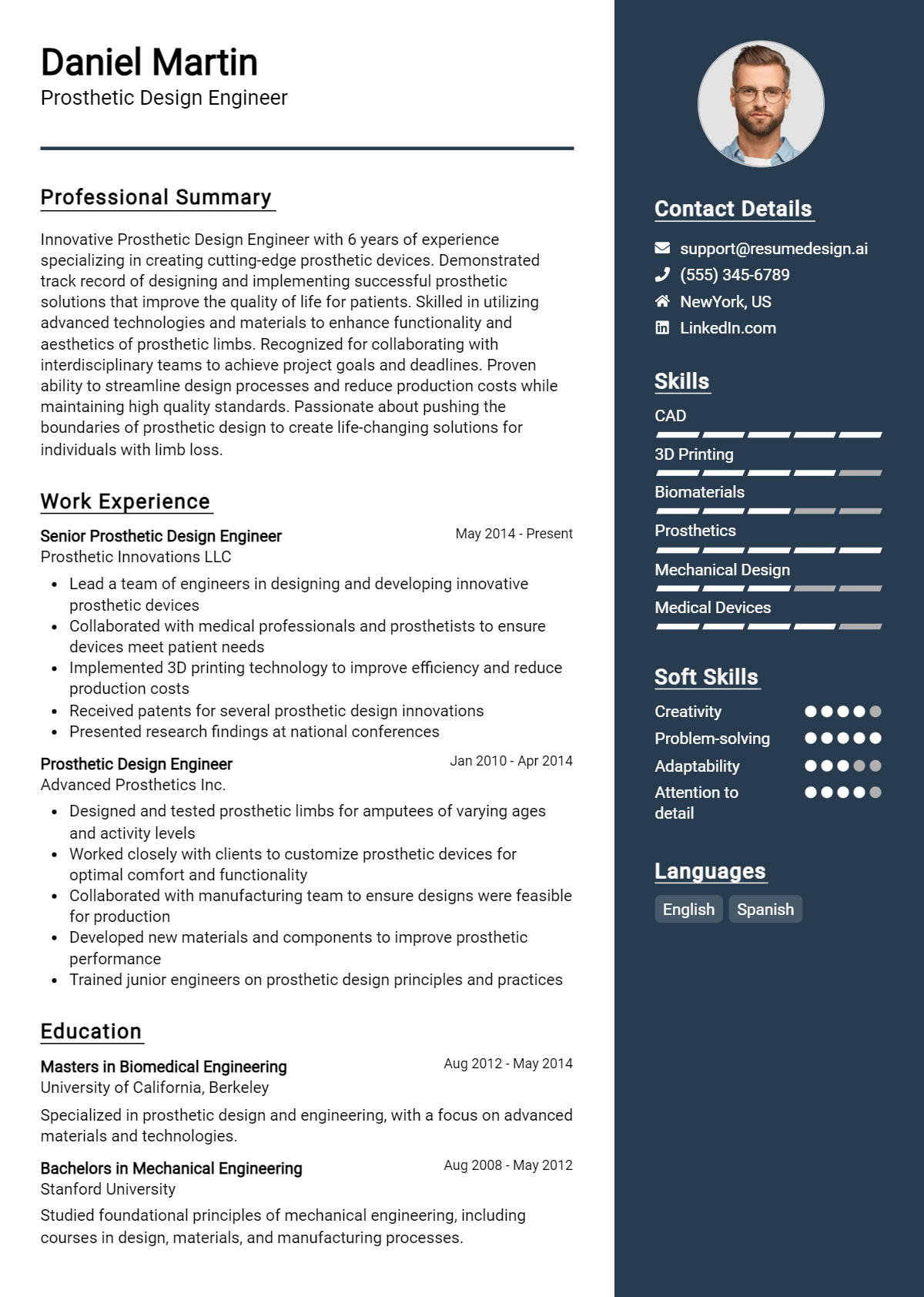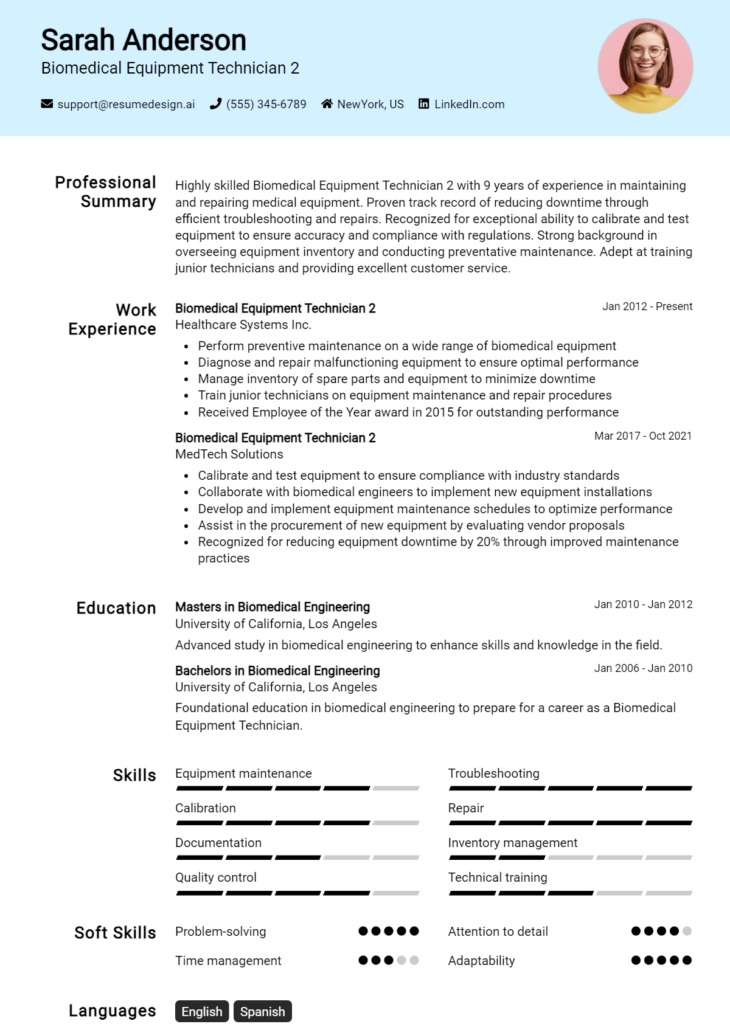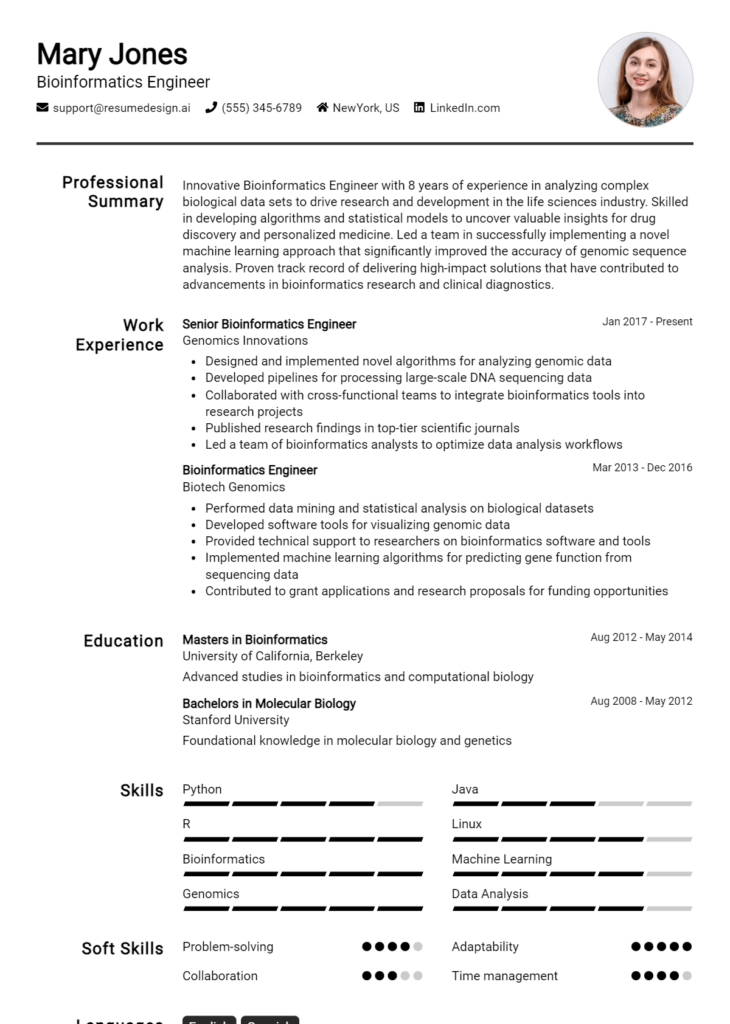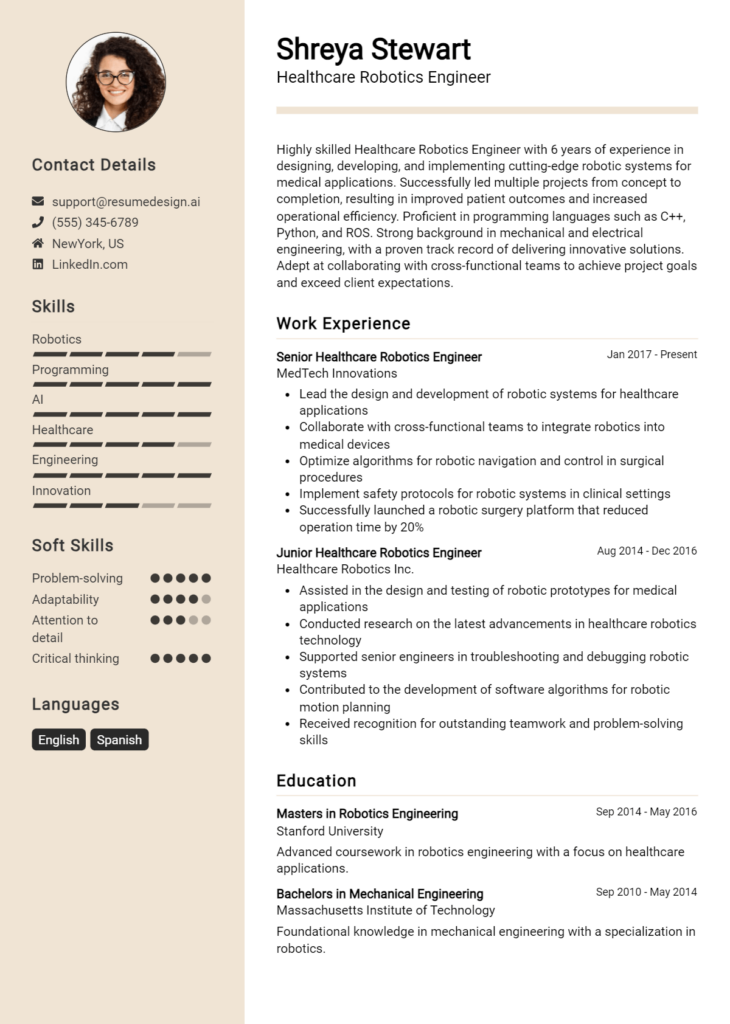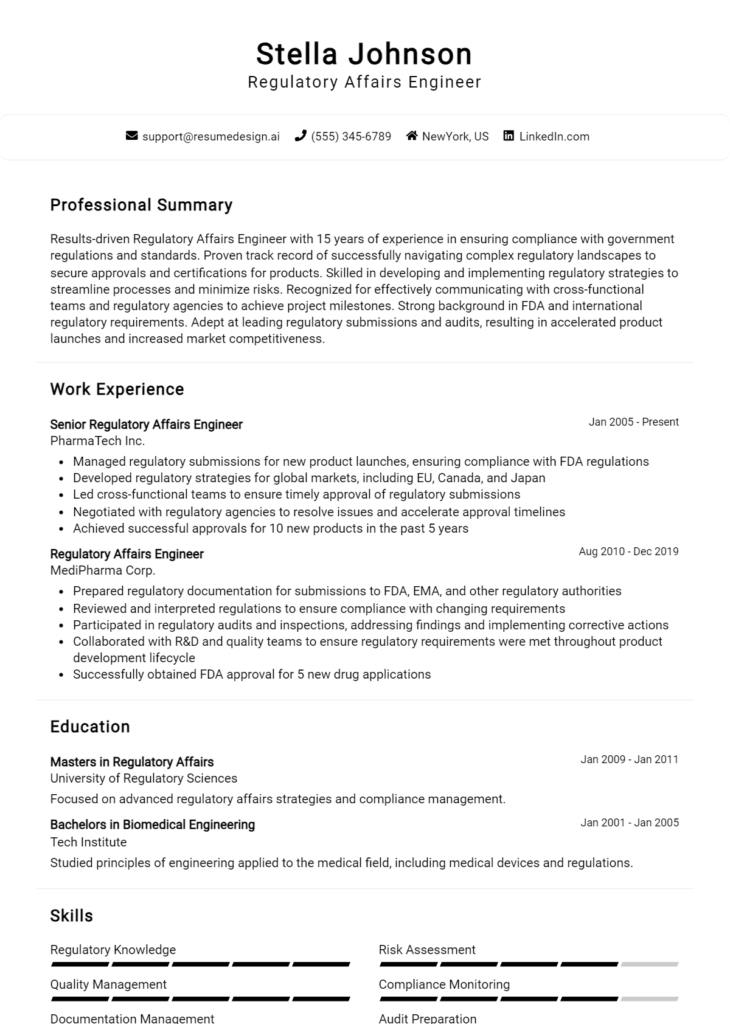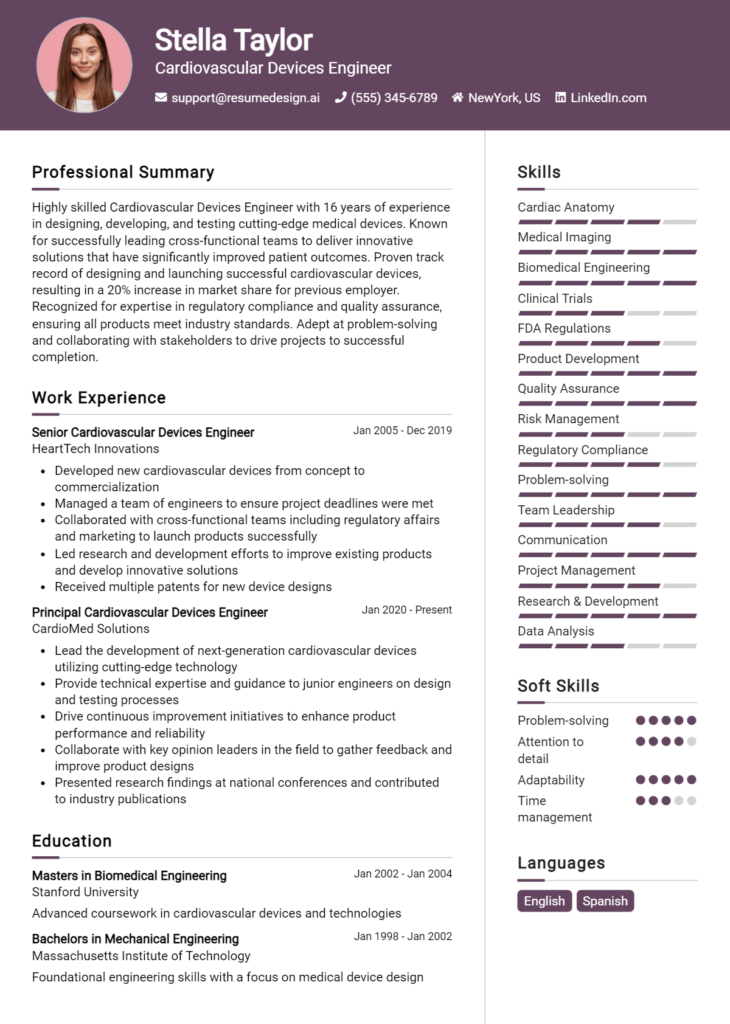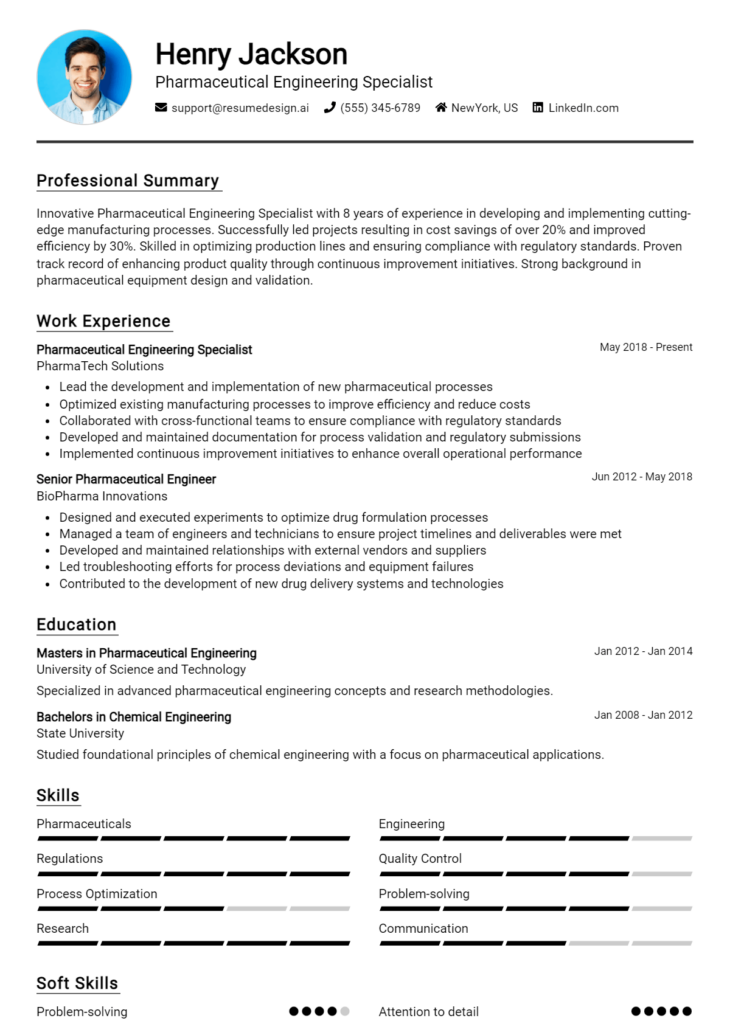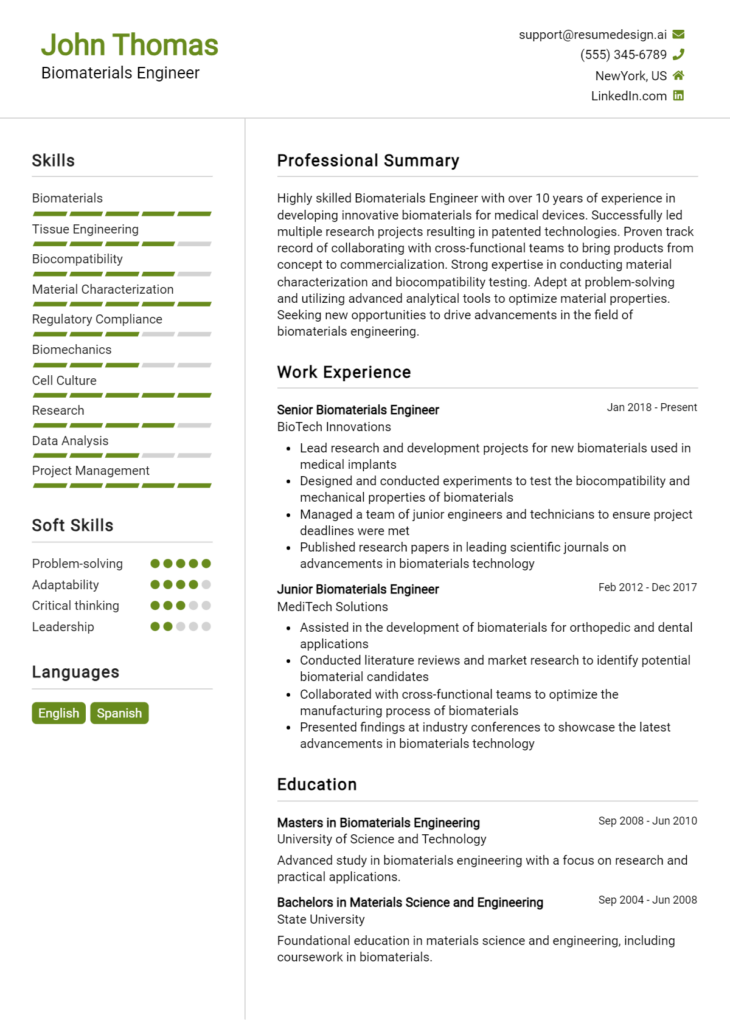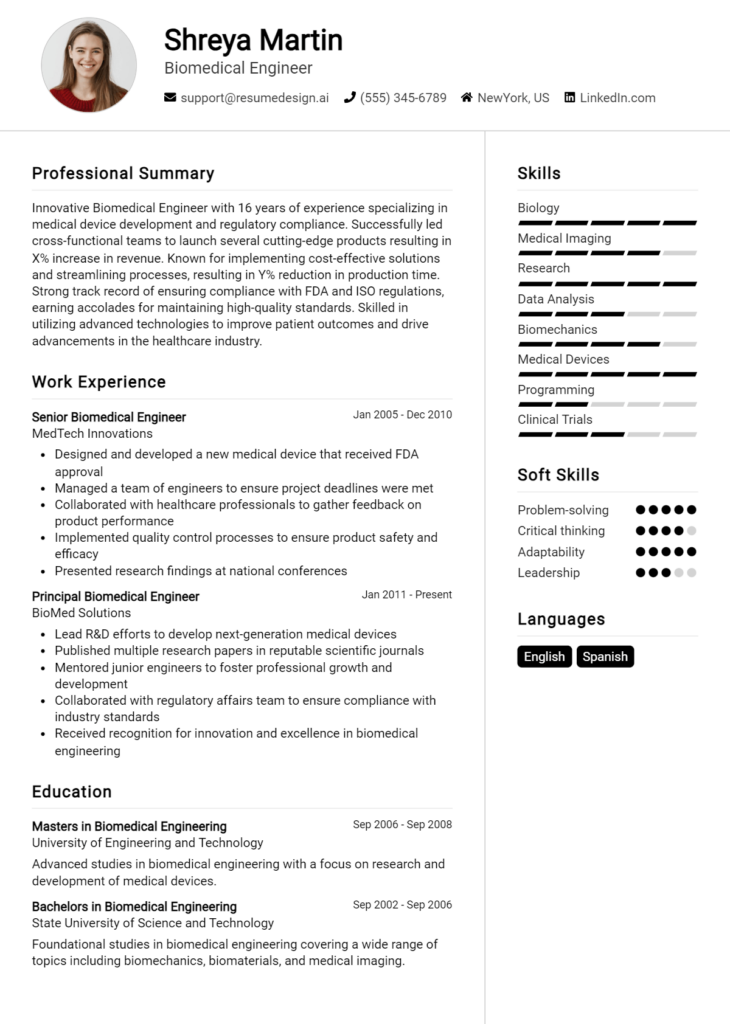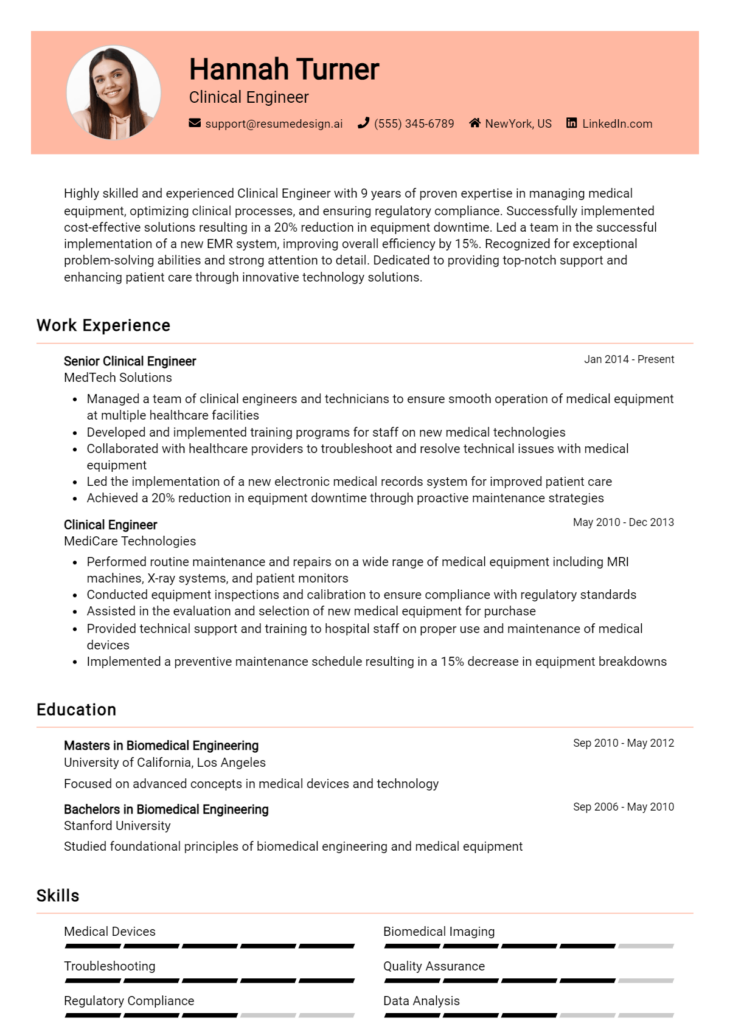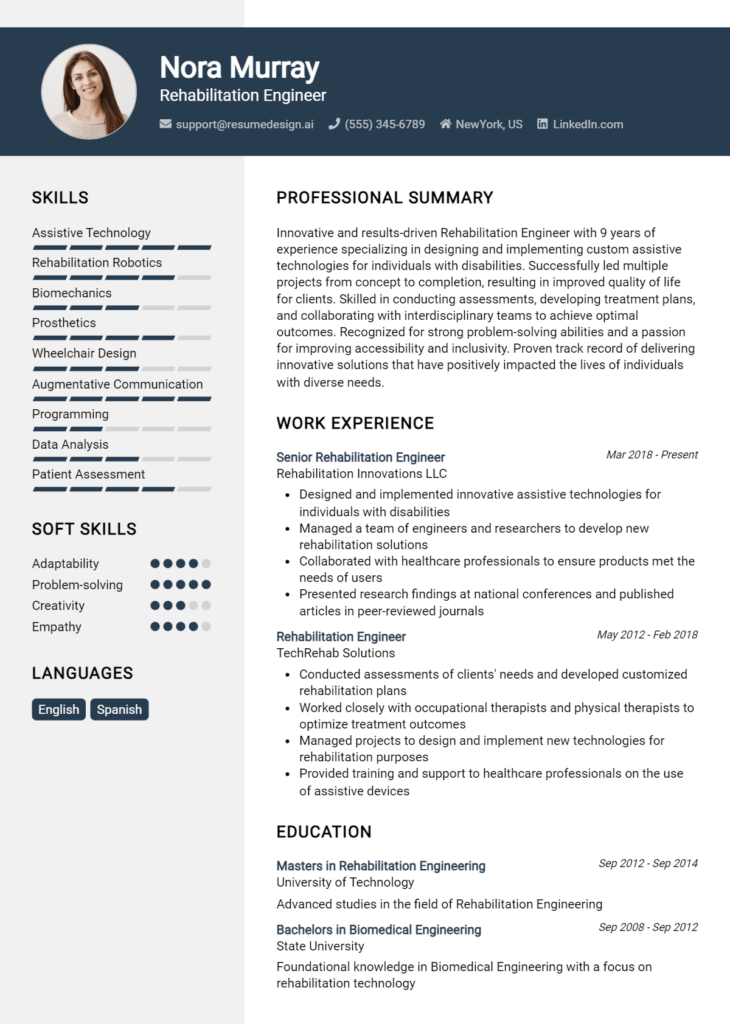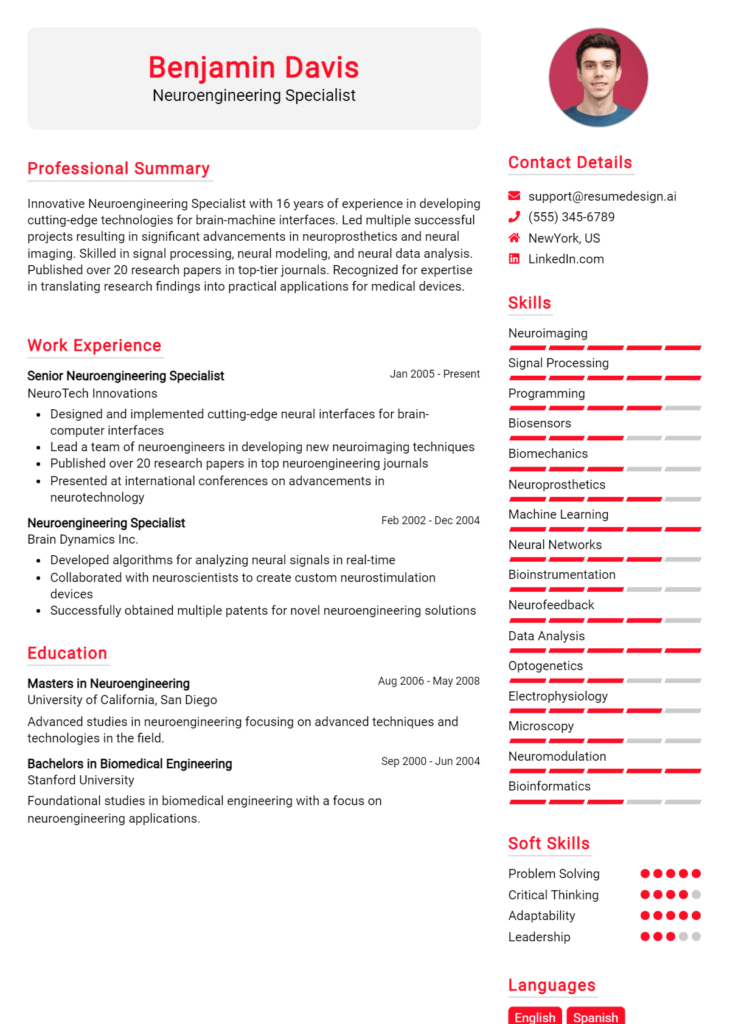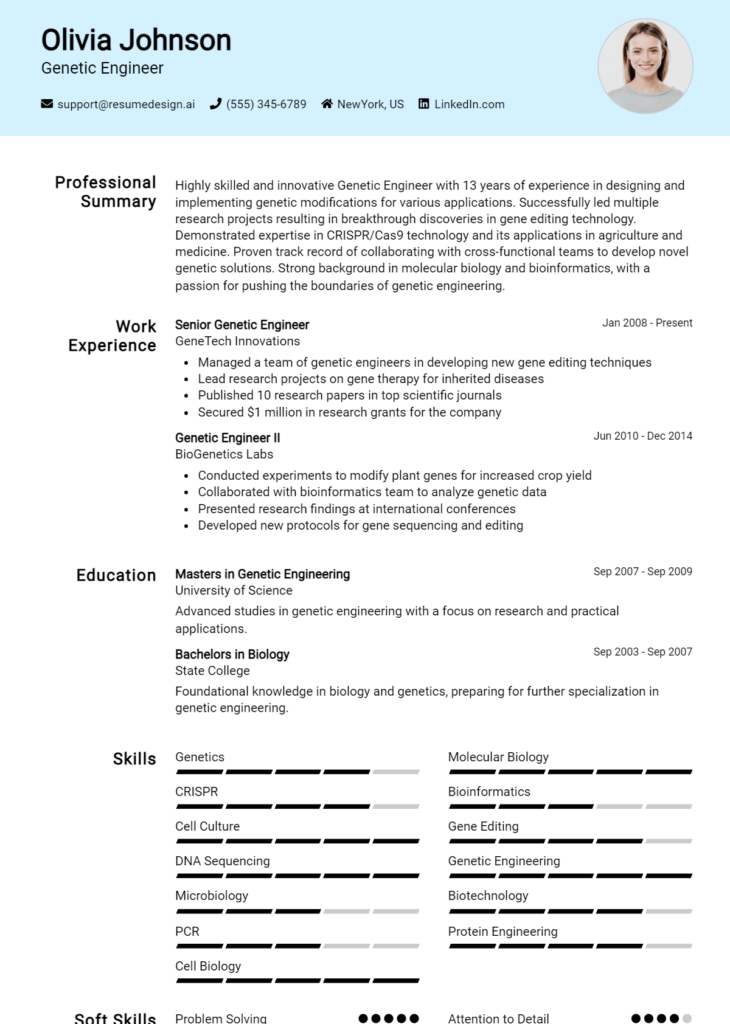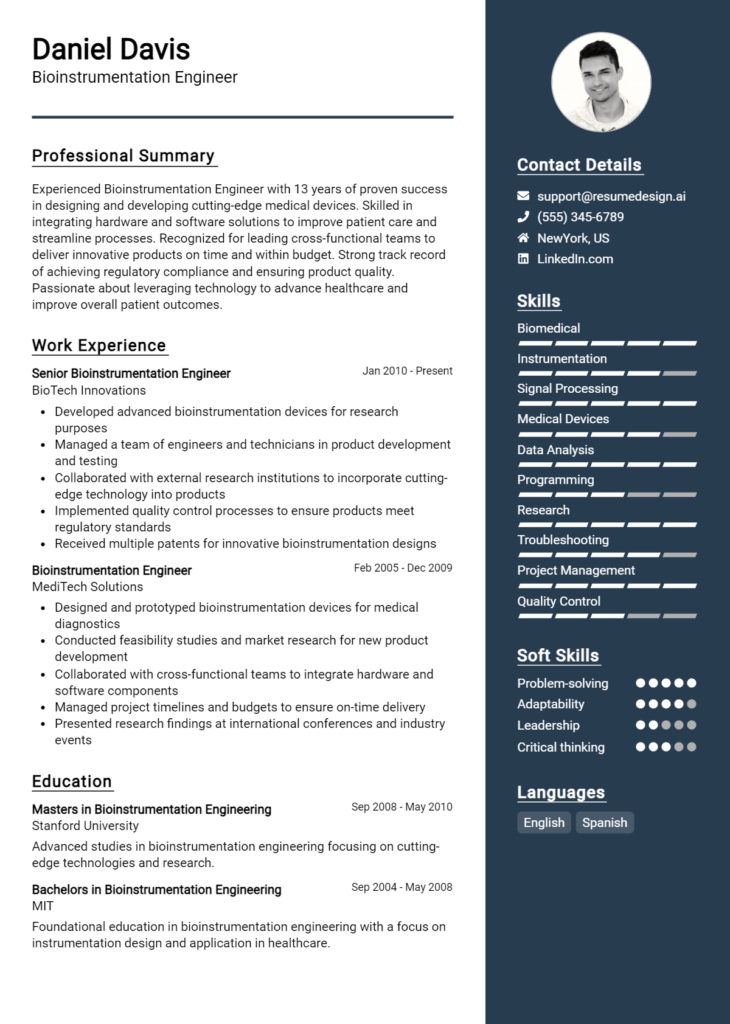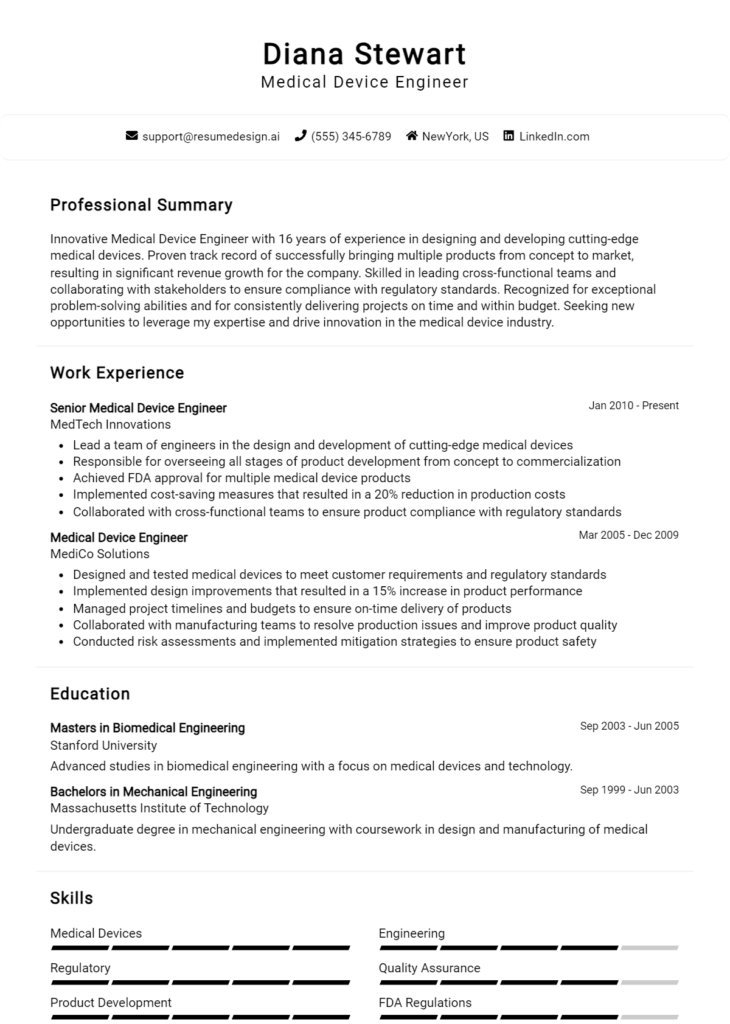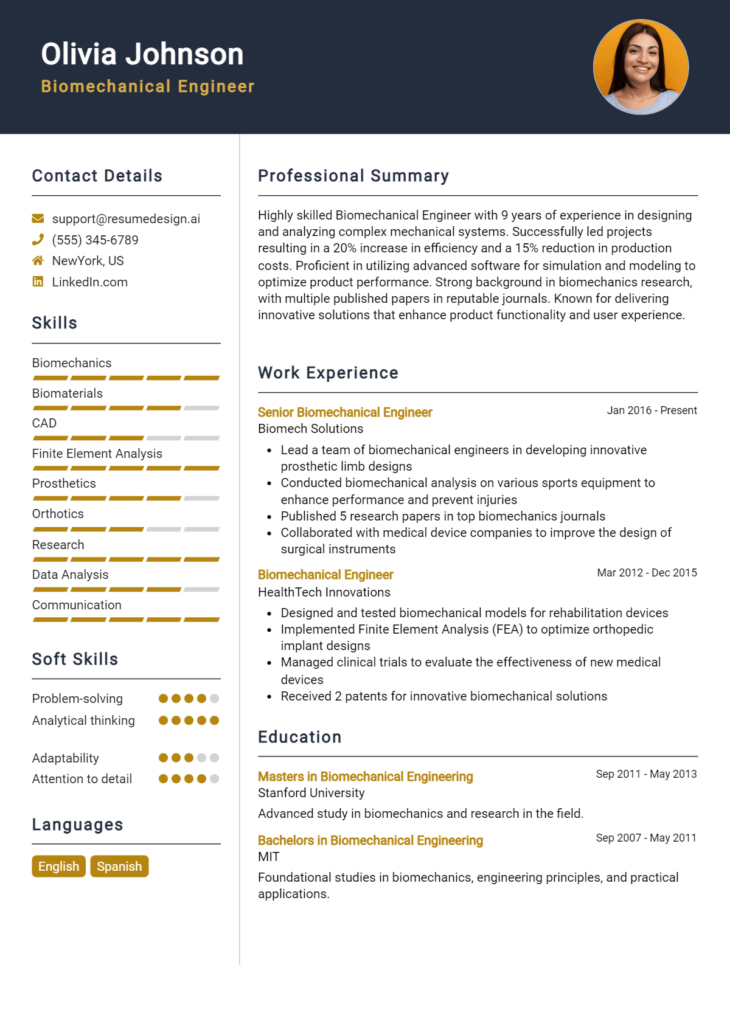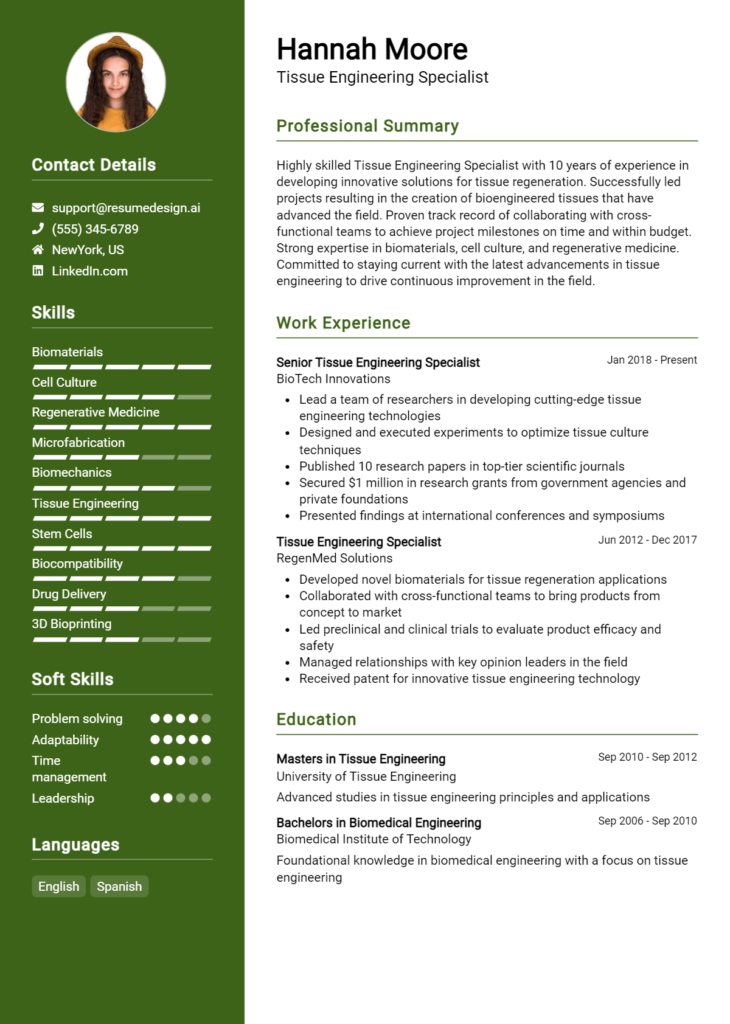Prosthetic Design Engineer Core Responsibilities
A Prosthetic Design Engineer is responsible for creating innovative prosthetic devices that enhance the quality of life for individuals with limb loss. This role requires technical expertise in materials and biomechanics, operational skills to collaborate with clinicians and manufacturers, and problem-solving abilities to address individual patient needs. By bridging engineering, healthcare, and manufacturing departments, these professionals significantly contribute to organizational goals by improving product functionality and patient satisfaction. A well-structured resume highlighting these skills is essential for showcasing expertise and attracting potential employers.
Common Responsibilities Listed on Prosthetic Design Engineer Resume
- Design and develop custom prosthetic devices based on patient specifications.
- Conduct material selection and testing to ensure durability and comfort.
- Collaborate with healthcare professionals to assess patient needs.
- Utilize CAD software for 3D modeling and simulation of prosthetic designs.
- Oversee the manufacturing process to ensure quality and precision.
- Provide technical support and guidance to patients and clinicians.
- Perform regular evaluations and adjustments of prosthetic devices.
- Stay updated with advancements in prosthetic technology and materials.
- Prepare detailed documentation and reports on design processes.
- Participate in interdisciplinary team meetings to align objectives.
- Implement feedback from clinical trials to improve design functionality.
- Ensure compliance with industry regulations and safety standards.
High-Level Resume Tips for Prosthetic Design Engineer Professionals
In the competitive field of prosthetic design engineering, a well-crafted resume serves as your first and most crucial introduction to potential employers. It’s not just a list of past jobs; it’s a strategic marketing tool that presents your unique skills, experiences, and achievements in a way that resonates with hiring managers. Given the specialized nature of this profession, your resume must effectively communicate your technical abilities, creativity, and problem-solving skills. This guide aims to equip Prosthetic Design Engineer professionals with practical and actionable resume tips tailored to stand out in this dynamic field.
Top Resume Tips for Prosthetic Design Engineer Professionals
- Tailor your resume for each job application by closely analyzing the job description and incorporating relevant keywords.
- Highlight your educational background, focusing on degrees, certifications, and specialized training in prosthetics and biomedical engineering.
- Showcase relevant experience by detailing specific projects where you designed or improved prosthetic devices, including any collaborative work with healthcare professionals.
- Quantify your achievements with metrics, such as the number of successful designs, improvements in user satisfaction, or reductions in production costs.
- Include industry-specific skills, such as proficiency in CAD software, materials science, biomechanical analysis, and prototyping techniques.
- Incorporate a section for professional affiliations, highlighting memberships in organizations like the American Academy of Orthotists and Prosthetists.
- Use action verbs to describe your contributions and responsibilities, creating a dynamic and engaging narrative of your career.
- Keep your design clean and professional, ensuring that the layout is easy to read and visually appealing to maintain the reader's attention.
- Proofread meticulously to eliminate any grammatical errors or typos, as attention to detail is critical in engineering roles.
By implementing these tailored resume tips, Prosthetic Design Engineer professionals can significantly enhance their chances of landing a job in this specialized field. A well-structured and thoughtfully crafted resume not only showcases your qualifications but also reflects your dedication to the profession, making you a standout candidate in the eyes of potential employers.
Why Resume Headlines & Titles are Important for Prosthetic Design Engineer
In the highly specialized field of prosthetic design engineering, a well-crafted resume headline or title serves as a powerful first impression that can set the tone for the entire application. A strong headline immediately grabs the attention of hiring managers by summarizing a candidate's key qualifications in one impactful phrase. This brief yet relevant statement should encapsulate the essence of the candidate's expertise and align closely with the job being applied for. By being concise and focused, an effective resume headline can not only spark interest but also make it easier for hiring managers to recognize the candidate's suitability for the role.
Best Practices for Crafting Resume Headlines for Prosthetic Design Engineer
- Keep it concise: Aim for a headline that is no longer than one or two lines.
- Be specific: Tailor your headline to reflect the specific role and skills required for the prosthetic design engineer position.
- Highlight key strengths: Use powerful adjectives or action verbs to showcase your most significant accomplishments or skills.
- Incorporate industry terminology: Use relevant jargon or keywords that resonate with the prosthetic design engineering field.
- Avoid generic terms: Steer clear of vague phrases that don’t convey your unique qualifications.
- Showcase achievements: If possible, reference notable achievements or certifications that enhance your credibility.
- Maintain professionalism: Ensure that the tone and language reflect the professional nature of the role.
- Align with the job description: Carefully read the job posting and incorporate key terms that align with the employer's needs.
Example Resume Headlines for Prosthetic Design Engineer
Strong Resume Headlines
Innovative Prosthetic Design Engineer with 10+ Years of Experience in Advanced Biomechanics
Expert in Custom Prosthetic Solutions: Proven Track Record in Enhancing Patient Mobility
Award-Winning Prosthetic Engineer Specializing in 3D Printing and Patient-Centric Designs
Weak Resume Headlines
Engineer Looking for Opportunities
Prosthetic Designer with Some Experience
Strong headlines are effective because they directly convey the candidate's unique qualifications, specific skills, and relevant experience related to the prosthetic design engineering field. They draw the reader in and provide a clear snapshot of what the candidate brings to the table. Conversely, weak headlines fail to impress because they are vague and non-specific, lacking the necessary detail to capture the interest of hiring managers. By not highlighting specific skills or achievements, they miss the opportunity to differentiate the candidate in a competitive job market.
Writing an Exceptional Prosthetic Design Engineer Resume Summary
A well-crafted resume summary is crucial for a Prosthetic Design Engineer, as it serves as the first impression for hiring managers. This brief section provides an opportunity to highlight key skills, relevant experience, and noteworthy accomplishments that align with the job role. A strong summary can quickly capture attention, enticing recruiters to delve deeper into the resume. It should be concise, impactful, and tailored specifically to the job description, ensuring that the candidate stands out in a competitive field.
Best Practices for Writing a Prosthetic Design Engineer Resume Summary
- Quantify Achievements: Use specific numbers and metrics to demonstrate the impact of your work.
- Focus on Relevant Skills: Highlight technical skills, software proficiency, and design methodologies pertinent to prosthetic engineering.
- Tailor for the Job Description: Customize your summary to reflect the key requirements and responsibilities outlined in the job posting.
- Use Action-Oriented Language: Start sentences with strong action verbs to convey confidence and initiative.
- Mention Industry Experience: Include years of experience and key projects that relate to prosthetic design and development.
- Showcase Problem-Solving Abilities: Highlight instances where you've successfully addressed challenges in prosthetic design.
- Keep it Concise: Aim for 2-4 sentences that succinctly encapsulate your qualifications without overwhelming the reader.
- Maintain Professional Tone: Use formal language and avoid colloquialisms to convey professionalism.
Example Prosthetic Design Engineer Resume Summaries
Strong Resume Summaries
Detail-oriented Prosthetic Design Engineer with over 5 years of experience in developing innovative prosthetic solutions. Successfully increased patient mobility by 30% through the design of a customized knee prosthesis that integrates advanced materials and biomechanics.
Results-driven engineer with a solid background in 3D modeling and CAD software, delivering over 15 successful prosthetic designs annually. Recognized for reducing production costs by 20% while maintaining high standards of functionality and comfort.
Creative Prosthetic Design Engineer skilled in user-centered design principles and advanced manufacturing techniques. Led a team project that improved the fit of upper-limb prosthetics, resulting in a 40% increase in user satisfaction based on feedback surveys.
Weak Resume Summaries
Prosthetic design engineer with experience in various projects. Skilled in engineering and design.
Dedicated engineer looking for opportunities in prosthetics. Good at problem-solving and teamwork.
The strong resume summaries are considered effective because they provide specific achievements, quantifiable results, and relevant skills that directly relate to the role of a Prosthetic Design Engineer. They also demonstrate the candidate’s ability to make a tangible impact in their field. Conversely, the weak summaries lack detail and specificity, making them too vague and generic to capture the interest of hiring managers effectively.
Work Experience Section for Prosthetic Design Engineer Resume
The work experience section of a Prosthetic Design Engineer resume is critical as it provides prospective employers with a clear understanding of the candidate's technical skills, leadership abilities, and capacity to deliver high-quality products. This section serves as a platform to showcase relevant professional experiences, emphasizing the candidate's proficiency in prosthetic design, engineering principles, and collaboration with multidisciplinary teams. By quantifying achievements and aligning their experiences with industry standards, candidates can effectively demonstrate their value and readiness for the role, increasing their chances of securing an interview.
Best Practices for Prosthetic Design Engineer Work Experience
- Clearly outline technical skills relevant to prosthetic design and engineering.
- Quantify achievements with specific metrics to illustrate impact and success.
- Highlight collaboration with cross-functional teams to showcase teamwork abilities.
- Use action verbs to convey proactive involvement in projects.
- Align descriptions with industry standards and best practices to demonstrate relevance.
- Include any leadership roles or project management experience to indicate capability in guiding teams.
- Tailor experience descriptions to match the job requirements and responsibilities.
- Keep entries concise and focused on the most impactful contributions.
Example Work Experiences for Prosthetic Design Engineer
Strong Experiences
- Led a team of 5 engineers in the design and implementation of a new line of high-performance prosthetic limbs, resulting in a 30% increase in patient satisfaction ratings.
- Developed a bespoke prosthetic limb for a veteran that improved mobility by 40%, validated through user testing and feedback.
- Collaborated with orthopedic specialists and patients to refine design specifications, reducing production costs by 15% while maintaining quality standards.
- Managed the integration of advanced materials in prosthetic design, leading to a 25% reduction in weight and enhanced durability.
Weak Experiences
- Worked on various projects related to prosthetics.
- Assisted in the design process without specific details or outcomes.
- Participated in team meetings to discuss prosthetic designs.
- Involved in engineering tasks for prosthetic development.
The examples provided illustrate a clear distinction between strong and weak experiences. Strong experiences are characterized by specific, quantifiable outcomes that highlight technical leadership and collaboration, demonstrating the candidate’s impact on projects. In contrast, weak experiences lack detail and quantifiable results, making them less compelling to potential employers. Clear accomplishments and active roles in projects enhance the overall impression of a candidate's capabilities, while vague descriptions fail to convey significant contributions or expertise.
Education and Certifications Section for Prosthetic Design Engineer Resume
The education and certifications section in a Prosthetic Design Engineer resume is crucial as it showcases the candidate's academic background and specialized knowledge in the field. It reflects their commitment to the profession through relevant degrees, industry-recognized certifications, and ongoing education efforts. By including pertinent coursework and specialized training, candidates can significantly enhance their credibility, demonstrating their technical proficiency and alignment with the demands of the job role. This section serves not only as proof of qualifications but also as an indication of the candidate's dedication to continuous learning and professional development in the ever-evolving field of prosthetics.
Best Practices for Prosthetic Design Engineer Education and Certifications
- Include degrees that are relevant to prosthetic design, such as Biomedical Engineering or Mechanical Engineering.
- Highlight industry-recognized certifications, such as Certified Prosthetist or Orthotist.
- Provide detailed information on relevant coursework, particularly in biomechanics, materials science, and CAD design.
- List any specialized training programs or workshops that enhance skills applicable to prosthetic design.
- Ensure that all certifications are up-to-date and relevant to current industry standards.
- Use clear formatting to separate degrees, certifications, and coursework, making it easy for employers to scan.
- Consider including online courses or MOOCs that are relevant to recent advancements in prosthetic technology.
- Keep the section concise but informative, focusing on the most impactful qualifications.
Example Education and Certifications for Prosthetic Design Engineer
Strong Examples
- Bachelor of Science in Biomedical Engineering, University of XYZ, Graduated May 2021
- Certified Prosthetist (CP) through the American Board for Certification in Orthotics, Prosthetics & Pedorthics
- Relevant Coursework: Advanced Biomechanics, CAD for Prosthetics, Materials for Medical Devices
- Completed a workshop on 3D Printing Technologies for Prosthetic Applications, June 2022
Weak Examples
- Bachelor of Arts in History, University of ABC, Graduated May 2018
- Certification in Basic First Aid (outdated and not relevant)
- Completed a course in General Computer Skills, January 2020
- High School Diploma, Graduated 2015 (not applicable to professional qualifications)
The strong examples are considered relevant and impactful as they directly align with the skills and knowledge required for a Prosthetic Design Engineer role, showcasing a combination of applicable education and certifications. In contrast, the weak examples lack relevance to the field of prosthetics, either by representing outdated qualifications or by being unrelated to the technical skills necessary for success in this profession. This contrast highlights the importance of tailoring the education and certifications section to the specific job requirements.
Top Skills & Keywords for Prosthetic Design Engineer Resume
In the highly specialized field of prosthetic design engineering, showcasing the right skills on your resume is crucial for standing out to potential employers. A well-crafted resume not only highlights your technical abilities but also emphasizes essential soft skills that demonstrate your capability to collaborate effectively within multidisciplinary teams. By strategically incorporating both hard and soft skills, you create a comprehensive picture of your qualifications, making it easier for hiring managers to recognize your value. Understanding the importance of these skills can significantly enhance your chances of securing the ideal role in the ever-evolving landscape of prosthetic technology.
Top Hard & Soft Skills for Prosthetic Design Engineer
Soft Skills
- Effective communication
- Team collaboration
- Problem-solving
- Attention to detail
- Time management
- Adaptability
- Creativity
- Critical thinking
- Empathy
- Project management
Hard Skills
- CAD software proficiency (e.g., SolidWorks, AutoCAD)
- Understanding of biomechanics
- Materials science knowledge
- 3D modeling and printing
- Manufacturing processes
- Regulatory compliance (FDA, ISO standards)
- Prosthetic design principles
- Data analysis and testing methods
- Knowledge of electrical components (for bionic devices)
- Familiarity with user-centered design methodologies
By focusing on both skills and relevant work experience, you can create a compelling resume that effectively showcases your qualifications as a Prosthetic Design Engineer.
Stand Out with a Winning Prosthetic Design Engineer Cover Letter
Dear [Hiring Manager's Name],
I am writing to express my interest in the Prosthetic Design Engineer position at [Company Name], as advertised on [where you found the job posting]. With a solid background in biomedical engineering and a passion for developing innovative solutions that enhance the quality of life for individuals with limb loss, I am excited about the opportunity to contribute to your team. My experience in CAD design, material selection, and user-centered design principles has equipped me with the skills necessary to create functional and aesthetically pleasing prosthetic devices.
During my time at [Previous Company Name], I successfully led a project that involved the design and prototype development of a new prosthetic limb that reduced weight by 30% while maintaining structural integrity. This project not only improved the user experience but also received positive feedback from both patients and healthcare professionals. My ability to collaborate with cross-functional teams, including physiotherapists and patients, allowed me to gather valuable insights that informed the design process, ensuring the final product met real-world needs effectively.
In addition to my technical skills, I am committed to staying updated on the latest advancements in prosthetic technology. I regularly attend industry conferences and workshops, which have allowed me to network with professionals and learn about cutting-edge materials and manufacturing techniques. I believe that my proactive approach to professional development, combined with my hands-on experience in prosthetic design, aligns well with [Company Name]'s mission to push the boundaries of prosthetic technology.
I am truly excited about the possibility of joining your team and contributing to groundbreaking projects that make a meaningful difference in people's lives. Thank you for considering my application. I look forward to the opportunity to discuss how my skills and experiences align with the goals of [Company Name] in more detail.
Sincerely,
[Your Name]
[Your LinkedIn Profile]
[Your Contact Information]
Common Mistakes to Avoid in a Prosthetic Design Engineer Resume
When crafting a resume for the role of a Prosthetic Design Engineer, it's essential to avoid common pitfalls that can undermine your qualifications and potential. A well-structured resume not only highlights your technical skills and experience but also presents them in a manner that captures the attention of hiring managers. Here are some common mistakes to steer clear of, ensuring your resume effectively showcases your strengths and suitability for the position.
Lack of Tailoring: Failing to customize your resume for each job application can make your qualifications seem generic. Tailoring your resume to highlight relevant skills and experiences can significantly improve your chances of standing out.
Ignoring Keywords: Many employers use Applicant Tracking Systems (ATS) to screen resumes. Not incorporating relevant industry keywords can result in your resume being overlooked. Research the job description and use appropriate terminology to enhance visibility.
Overloading with Technical Jargon: While technical knowledge is crucial, using excessive jargon can confuse readers who may not have a deep understanding of the field. Strive for a balance between technical terms and clear explanations.
Neglecting Soft Skills: Focusing solely on technical skills and neglecting soft skills such as communication, teamwork, and problem-solving can be a mistake. These qualities are essential in collaborative environments and should be highlighted.
Inconsistent Formatting: A disorganized or inconsistent format can make your resume difficult to read. Use a clean, professional layout with consistent fonts, bullet points, and spacing to ensure clarity.
Too Much or Too Little Detail: Providing either excessive detail or being overly vague about your experiences can be detrimental. Aim for a concise yet informative description of your responsibilities and achievements in previous roles.
Omitting Relevant Projects: Failing to include specific projects or accomplishments related to prosthetic design can weaken your application. Highlighting relevant projects demonstrates your practical experience and expertise.
Ignoring Proofreading: Spelling and grammatical errors can undermine your professionalism. Always proofread your resume or have someone else review it to catch any mistakes that could detract from your qualifications.
Conclusion
As we explored the multifaceted role of a Prosthetic Design Engineer, it became clear that this position requires a unique blend of creativity, technical expertise, and a deep understanding of human anatomy. Key responsibilities include collaborating with healthcare professionals to develop innovative prosthetic devices, utilizing advanced materials to enhance functionality and comfort, and staying abreast of technological advancements in the field. Effective communication skills are essential, as is the ability to empathize with patients to ensure their needs are met.
Given the competitive nature of this field, it's crucial to present a strong resume that highlights your relevant skills and experiences. If you haven't reviewed your Prosthetic Design Engineer resume recently, now is the perfect time to do so. Take advantage of the various resources available to elevate your application. Consider using resume templates to create a polished and professional look, or try the resume builder for a user-friendly experience. Don't forget to check out resume examples for inspiration and to ensure you're showcasing your qualifications effectively. Additionally, a well-crafted cover letter can set you apart, so explore the cover letter templates to make a lasting impression.
Take action today to refine your resume and enhance your prospects in the exciting and rewarding field of prosthetic design engineering!

